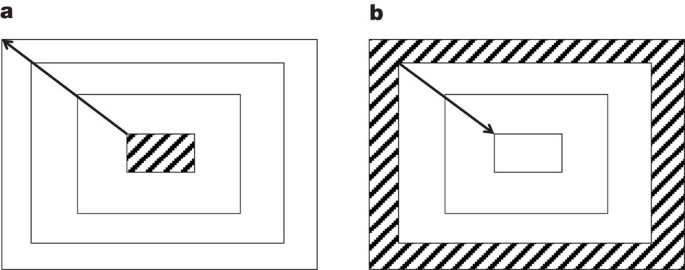
Geometry and scale in species–area relationships
- Select a language for the TTS:
- UK English Female
- UK English Male
- US English Female
- US English Male
- Australian Female
- Australian Male
- Language selected: (auto detect) - EN
Play all audios:

ABSTRACT Arising from F. He & S. P. Hubbell _Nature_ 473, 368–371 (2011)10.1038/nature09985. He and Hubbell developed a sampling theory for the species–area relationship (SAR) and the
endemics–area relationship (EAR)1. They argued that the number of extinctions after habitat loss is described by the EAR and that extinction rates in previous studies are overestimates
because the EAR is always lower than the SAR. Here we show that their conclusion is not general and depends on the geometry of habitat destruction and the scale of the SAR. We also question
their critique of the Millennium Ecosystem Assessment estimates, as those estimates are not dependent on the SAR only, although important uncertainties remain due to other methodological
issues. Access through your institution Buy or subscribe This is a preview of subscription content, access via your institution ACCESS OPTIONS Access through your institution Subscribe to
this journal Receive 51 print issues and online access $199.00 per year only $3.90 per issue Learn more Buy this article * Purchase on SpringerLink * Instant access to full article PDF Buy
now Prices may be subject to local taxes which are calculated during checkout ADDITIONAL ACCESS OPTIONS: * Log in * Learn about institutional subscriptions * Read our FAQs * Contact customer
support SIMILAR CONTENT BEING VIEWED BY OTHERS SPECIES TURNOVER DOES NOT RESCUE BIODIVERSITY IN FRAGMENTED LANDSCAPES Article 12 March 2025 ECOSYSTEM DECAY EXACERBATES BIODIVERSITY LOSS
WITH HABITAT LOSS Article 29 July 2020 A QUIXOTIC VIEW OF SPATIAL BIAS IN MODELLING THE DISTRIBUTION OF SPECIES AND THEIR DIVERSITY Article Open access 03 May 2023 REFERENCES * He, F. &
Hubbell, S. P. Species–area relationships always overestimate extinction rates from habitat loss. _Nature_ 473, 368–371 (2011) Article ADS CAS Google Scholar * van Vuuren, D., Sala, O.
& Pereira, H. M. The future of vascular plant diversity under four global scenarios. _Ecol. Soc._ 11, 25 (2006) Article Google Scholar * Pimm, S. L., Russell, G. J., Gittleman, J. L.
& Brooks, T. M. The future of biodiversity. _Science_ 269, 347–350 (1995) Article ADS CAS Google Scholar * Reid, W. V. in _Tropical Deforestation and Species Extinction_ (eds
Whitmore, T. C. & Sayer, J. A. ) 53–73 (Chapman and Hall, 1992) Google Scholar * Kinzig, A. & Harte, J. Implications of endemics–area relationships for estimates of species
extinctions. _Ecology_ 81, 3305–3311 (2000) Google Scholar * Rosenzweig, M. L. Loss of speciation rate will impoverish future diversity. _Proc. Natl Acad. Sci. USA_ 98, 5404–5410 (2001)
Article ADS CAS Google Scholar * Dengler, J. Which function describes the species–area relationship best? A review and empirical evaluation. _J. Biogeogr._ 36, 728–744 (2009) Article
Google Scholar * Pereira, H. M. & Daily, G. C. Modeling biodiversity dynamics in countryside landscapes. _Ecology_ 87, 1877–1885 (2006) Article Google Scholar * Mace, G. M. et al. in
_Ecosystems and Human Well-being: Current States and Trends_ 77–126 (Millennium Ecosystem Assessment, 2005) Google Scholar * Mace, G. M. & Kunin, W. Classifying threatened species—means
and ends. _Phil. Trans. R. Soc. B_ 344, 91–97 (1994) Article ADS Google Scholar * Smith, F. D. M., May, R. M., Pellew, R., Johnson, T. H. & Walter, K. S. Estimating extinction rates.
_Nature_ 364, 494–496 (1993) Article ADS Google Scholar * Pereira, H. M. et al. Scenarios for global biodiversity in the 21st century. _Science_ 330, 1496–1501 (2010) Article ADS CAS
Google Scholar * Jetz, W., Wilcove, D. S. & Dobson, A. P. Projected impacts of climate and land-use change on the global diversity of birds. _PLoS Biol._ 5, e157 (2007) Article Google
Scholar * Sinervo, B. et al. Erosion of lizard diversity by climate change and altered thermal niches. _Science_ 328, 894–899 (2010) Article ADS CAS Google Scholar * Sekercioglu, C. H.,
Schneider, S. H., Fay, J. P. & Loarie, S. R. Climate change, elevational range shifts, and bird extinctions. _Conserv. Biol._ 22, 140–150 (2008) Article Google Scholar Download
references AUTHOR INFORMATION AUTHORS AND AFFILIATIONS * Centro de Biologia Ambiental, Faculdade de Ciências da Universidade de Lisboa, Lisboa, 1749-016, Portugal Henrique Miguel Pereira,
Luís Borda-de-Água & Inês Santos Martins Authors * Henrique Miguel Pereira View author publications You can also search for this author inPubMed Google Scholar * Luís Borda-de-Água View
author publications You can also search for this author inPubMed Google Scholar * Inês Santos Martins View author publications You can also search for this author inPubMed Google Scholar
CONTRIBUTIONS All authors participated in the discussion of the ideas that resulted in this paper. H.M.P. wrote the paper, L.B.-d.-A. performed the data analysis, and I.S.M. prepared the
data sets for analysis. CORRESPONDING AUTHOR Correspondence to Henrique Miguel Pereira. ETHICS DECLARATIONS COMPETING INTERESTS Declared none. POWERPOINT SLIDES POWERPOINT SLIDE FOR FIG. 1
POWERPOINT SLIDE FOR FIG. 2 RIGHTS AND PERMISSIONS Reprints and permissions ABOUT THIS ARTICLE CITE THIS ARTICLE Pereira, H., Borda-de-Água, L. & Martins, I. Geometry and scale in
species–area relationships. _Nature_ 482, E3–E4 (2012). https://doi.org/10.1038/nature10857 Download citation * Received: 05 June 2011 * Accepted: 20 December 2011 * Published: 22 February
2012 * Issue Date: 23 February 2012 * DOI: https://doi.org/10.1038/nature10857 SHARE THIS ARTICLE Anyone you share the following link with will be able to read this content: Get shareable
link Sorry, a shareable link is not currently available for this article. Copy to clipboard Provided by the Springer Nature SharedIt content-sharing initiative
